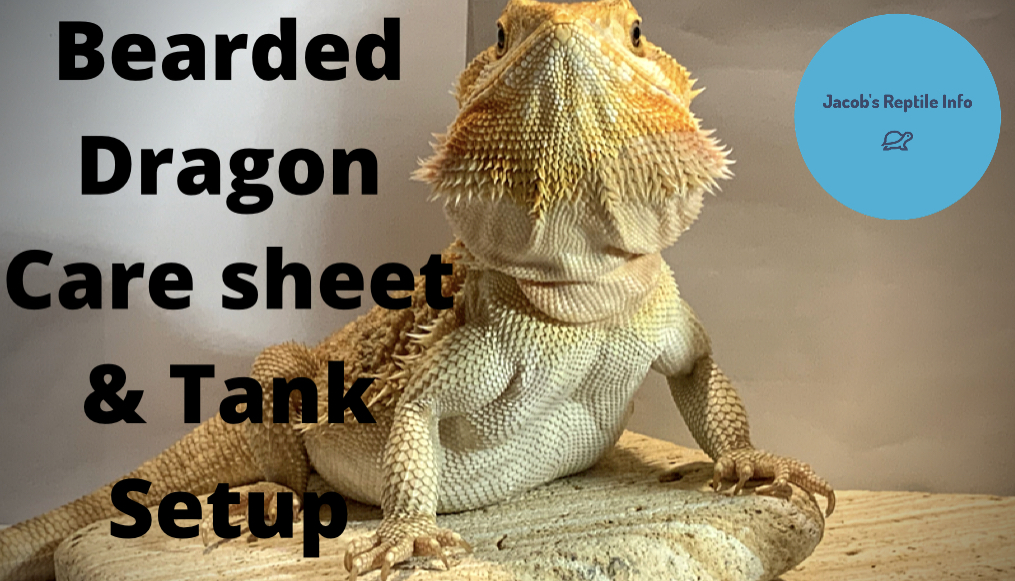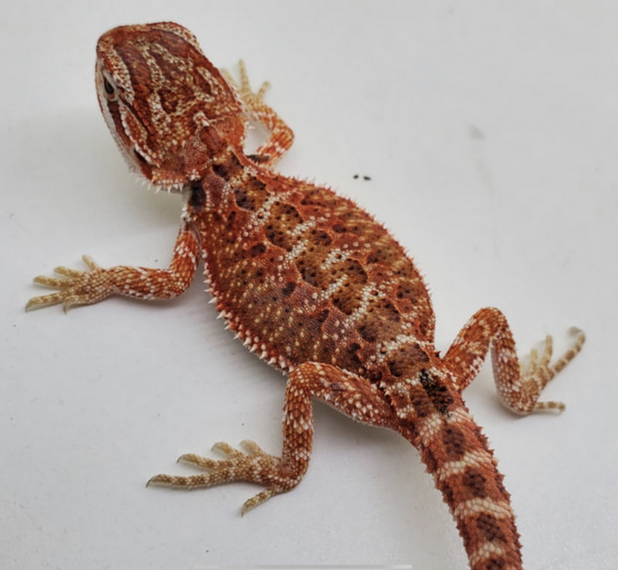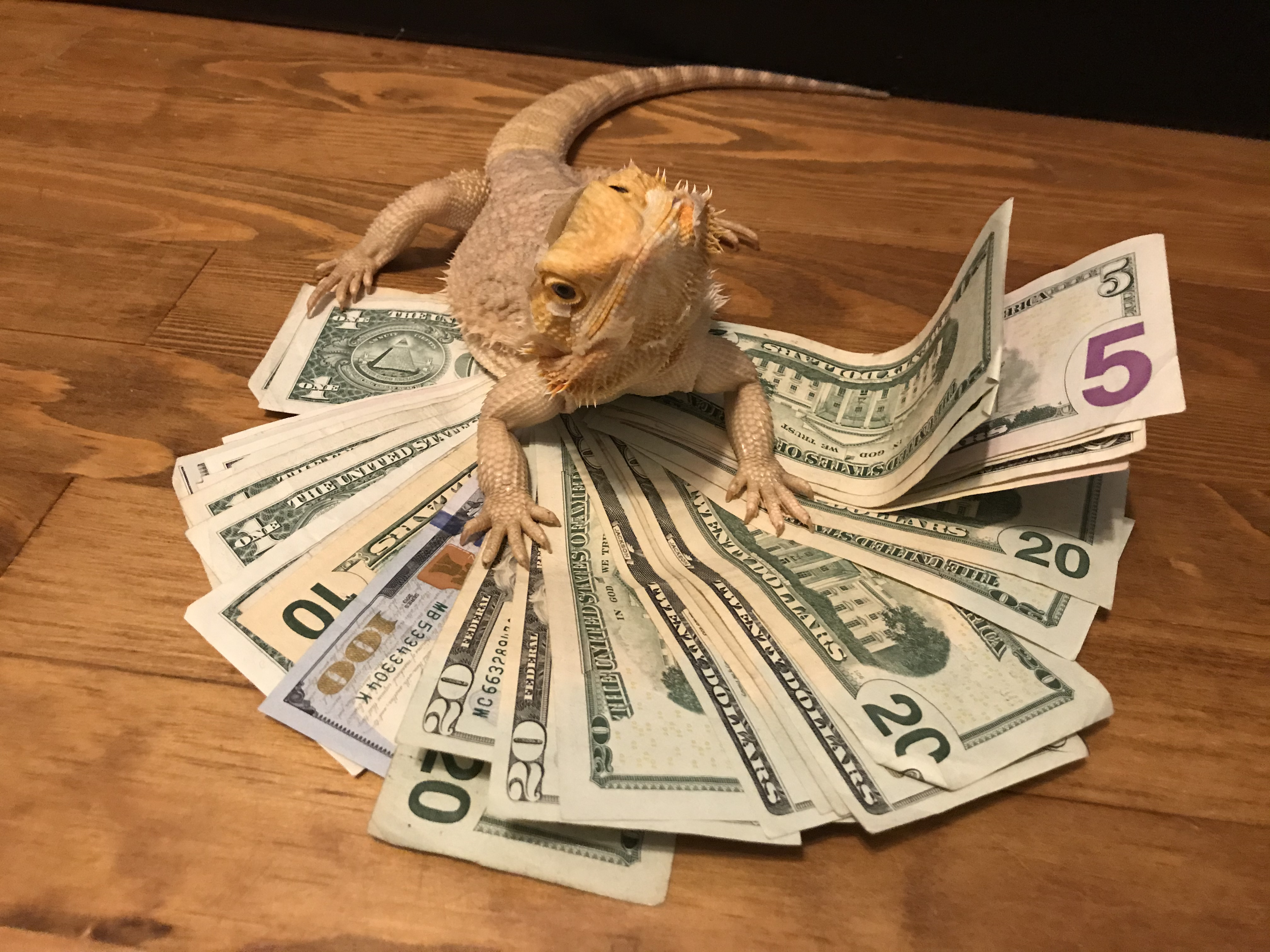Bearded Dragon Care
August 8, 2021
As an Amazon Associate I earn from qualifying purchases.

Bearded dragons are some of the best pet reptiles. They are very friendly and enjoy being with people. Bearded dragons require more care than other lizards, such as geckos. This bearded dragon care guide explains everything you will need to know about bearded dragon care, including tank setup, feeding, lighting requirements, and heating.
About Bearded Dragon Lizards
Bearded dragons are native to Australia and need high temperatures. They were first kept as pets in the 1990s. Bearded dragons can live 10-12 years in captivity. They eat both insects and vegetables.
Quick Facts
Appearance
Bearded dragons can be recognized by their spiky scales and “beard” (hence the name “bearded dragon”). The beard is the part under the head that is usually softer than the rest of the bearded dragon’s body. When they are threatened or scared, their beard flares out and sometimes even turns black. They also do this with their beard when they are shedding to help the old skin come off. Bearded dragons can get up to 24 inches long (some morphs are bigger than others). Unlike geckos, bearded dragons have eyelids. These lizards also have a “third eye”. This eye can not see, but instead, it senses shadows and heat. Bearded dragons have claws that need to be cut every 3-4 months.
Tank Requirements
Bearded dragons need a larger tank setup than other lizards. An adult bearded dragon tank should be at least 40 gallons. Baby bearded dragons can live in a 20-gallon long tank, but a 40-gallon tank is more preferable. Tanks with opening doors are great for bearded dragon lizards since the doors make feeding and handling easier. These lizards also need a mesh lid to their tank. Never use a glass or plastic lid because UVB light can not penetrate them. Bearded dragons should be housed alone unless they are babies.
Lighting and Heating
Like all reptiles, bearded dragons are cold-blooded and need UVB light to stay warm. This UVB light should be 80 watts. A good UVB light is the Exo Terra Solar-Glo Mercury Vapor Bulb. It provides UVB, UVA, and heat. Bearded dragons also need a ceramic heat emitter to stay warm at night. An excellent one is the Thrive Reptile Ceramic Heat Emitter. A heat mat for the tank is optional, but it is strongly recommended. Any reptile heat mat will work for bearded dragons. Bearded dragons also need a tube UVB light for their tank setup. A good tube UVB light is the Zoo Med Reptisun T5-Ho Terrarium Hood. Bearded dragon lizards also need reptile lamps to hold the UVB bulbs and heat emitter. These reptile lamps are available at almost every pet store. Industrial lamp holders from hardware stores also work too. Lighting is the most important part of a bearded dragon tank setup.
Tank Decor
Bearded dragons need decor that mimics their natural habitat to thrive. You should provide your bearded dragon with a spot to bask directly under the UVB bulb. There are reptile hammocks that are great for bearded dragons. Large rocks from reptile or aquarium stores also work well and can be supported with PVC pipes. Tiles from hardware stores also work well. Bearded dragons also like to climb and need some branches. There are ceramic branches at reptile stores that work well. Spider wood or driftwood also works well. These lizards also need a hiding spot. There are many reptile caves to choose from but make sure your bearded dragon can comfortably turn around in it. Fake plants can also be added but do not place them under the heat lamps because they will melt. Creating a habitat with lots of things for your bearded dragon is very important.
Substrate
Bearded dragons need a good substrate in their enclosure. There are many types of substrate including sand, reptile carpet, and tile. Although sand can be good and look natural, it should not be used as it can lead to impaction. Sand is also very messy and hard to clean. Reptile carpet is the easiest substrate for bearded dragons. It comes in many patterns and is inexpensive. The only downside to reptile carpet is that it can be hard to clean if your bearded dragon defecates on it. Tiles are easy to clean, but are very hard to install. Tiles can also be pricey if you do not have the supplies to cut them. Also, many bearded dragons do not like the texture of tiles. Another good bearded dragon substrate option is a yoga mat. It is easy to clean and is inexpensive. There are also substrate mats made specifically for bearded dragons. One of the best ones is the Zen Habitat Mat. It is easy to clean, and can be cut to work with any tank. Choosing the right substrate for your bearded dragon is very important.
Diet
Bearded dragons are omnivores, meaning that they can eat both meat and plants. A Bearded dragon’s diet should consist of live feeder insects, dark leafy greens, and fruits. A bearded dragon’s diet will change depending on their age. Baby bearded dragons eat about 80% bugs and 20% vegetables. Adults eat 20% bugs and 80% vegetables. Baby bearded dragons should eat bugs 2-3 times a day and have vegetables in their tank all day. Once your bearded dragon is 14 months old, you can start feeding them bugs once a day and leave vegetables in their tank all day. Feeding your bearded dragon too much or too little food can result in serious health problems, such as MBD.
Bugs that bearded dragons can eat are dubia roaches, crickets (banded or brown), waxworms, silkworms, super worms, mealworms, and hornworms. Hornworms should only be fed once in a while, and count as 3 meals since they are very filling. Dubia roaches are the best bugs to feed to your bearded dragon because they are extremely high in protein. You will also need separate containers to keep the bugs in. Waxworms, silkworms, super worms, mealworms, and hornworms usually come in disposable cups with enough food for a week. Dubia roaches and crickets usually do not come in containers. You can get cricket containers to keep the roaches and crickets in. For more information on caring for dubias and crickets, read the articles How to Take Care of Live Crickets and How to Take Care of Live Dubia Roaches. You can feed your bearded dragon in its tank or in a container. It is best to feed your bearded dragon in a container so the tank does not get a mess from the bugs. To do this, place your bearded dragon in a storage container without a lid, put calcium powder and bugs in a small bowl, and dump the bugs in the container with the lizard. Your beardie will start to chase the bugs around the container and viciously eat them. Once your bearded dragon is done, put them under the UVB light to warm up. If you do not put your lizard under the UVB light, they can get cold and not be able to digest the bugs.
Some vegetables that bearded dragons can eat include bok choy, kale, collard greens, butternut squash, bell peppers, and dandelion greens. Fruits that they can eat are strawberries, grapes, raspberries, watermelon, and blueberries. You can also feed your bearded dragon papaya, but make sure to take all the seeds out and chop or shred it. Fruit should only be fed once a week, or sparingly. Never feed your bearded dragon avocado because it is poisonous to them. You should provide your bearded dragon with fresh vegetables in a bowl in their tank. Feed your lizard the right amount of vegetables based on its age.
Handling a Bearded Dragon
Bearded dragons are very social lizards and love to be handled. Since bearded dragons are cold-blooded, they should not be handled for more than 30 minutes at a time. You should never touch a bearded dragon on the top of it’s head because bearded dragons have a “third eye”. Bearded dragons enjoy being petted under their beard and on their back. These lizards should never be picked up from their tail because if it falls off, they will not regenerate it. Avoid picking up a bearded dragon from above because they will think it is a predator. Instead, scoop under the lizard and pick it up. If a bearded dragon does not like how you are handling them, they will puff out their beard and sometimes body. Male bearded dragons are also known to turn their beards black when they feel threatened.
Morphs

There are many different types of bearded dragons called “morphs”. There are higher end morphs that usually cost more than normal bearded dragons. These lizards can cost up to $8,000 depending on their morph! Some common morphs are red morphs, zeros, witblits, paradoxes, leatherbacks, dunners, and weros. Paradoxes, weros, and zeros are usually the most expensive bearded dragon morphs. If you are getting your first bearded dragon, it is best to get a standard morph or a red morph because they are the least expensive.
Buying a Bearded dragon
Bearded dragons are sold at most pet stores, but you should not buy them there. Pet stores often treat their bearded dragons very bad. They are kept in overcrowded tanks, which makes it hard to compete for food. The best places to buy bearded dragons are reptile expos, breeders, and reptile stores. Most of the time, these bearded dragons are well taken care of by experienced reptile keepers. Some local pet stores are good since they source their beardies from small breeders. Bearded dragons can also be bought online. They are shipped with heat and cool packs so they do not get cold. Before buying a bearded dragon online, talk to the breeder and find out how they keep their lizards, how long they have been breeding lizards, ect to tell if they are reliable. Some great online bearded dragon breeders are Spice Dragons, Midwest Dragons, and Fire & Ice Dragons. You can also rescue a bearded dragon from a local rescue or sites like Emerald Scales. It is important to get your bearded dragon from a good place.
Other Information
Eggs
Female bearded dragons will lay eggs about once a year. They will do this even if they did not mate. Not all bearded dragons lay eggs, as some re-absorb them. When bearded dragons are about to lay eggs, they will start digging around their tank and try to rip up the reptile carpet. If your tank does not have sand, you will need to make a “dig box”. A dig box is a box or container full of sand with a UVB light above it. You can buy a 10 gallon tub at a hardware store and fill it with reptile sand. Some vets also recommend using a mixture of vermiculite and perlite (typically sold at gardening stores) instead of sand. The only downside to this is that it is extremely messy. When you think your bearded dragon is about to lay eggs, you should put her in the dig box. The whole egg laying process can take up to 3 hours and is very stressful. After she lays the eggs, she will need to eat something high in protein, such as dubia roaches.
Brumation
Bearded dragons can go through a stage called brumation. This is very similar to hibernation. During brumation, your bearded dragon will be very lazy and sleep for a long time. Some bearded dragons will not eat as much during this. Brumation is often confused with illnesses. Not all bearded dragons will go through brumation, but when it happens it will usually be during winter time. It is important to know about brumation so you do not confuse it with illness.
Nails
Bearded dragons have nails that need to be trimmed. Although you can do it yourself, it is better to take your beardie to a vet. Like dogs, bearded dragons have veins in their nails and can get severely injured if they are cut too short. If you accidentally cut it too short and it is bleeding, you can put cornstarch on it. This will stop the bleeding and the nail will heal soon.
Vet Visits
Bearded dragons need to get a check-up every year. They can not go to a regular vet though. Bearded dragons need to see a special reptile or exotic animal vet. When taking your bearded dragon to the vet, make sure it is warm out so your bearded dragon will not get cold. If there is an emergency and you have to take your beardie to the vet in the winter, wrap a towel around their container to keep them warm.
Total Cost

Bearded dragons cost more than most other lizards. The tank setup can range from $200 to $600. The dragon can range from $90 to $1,200. Overall, an average bearded dragon total cost is about $700.
Summary
Bearded dragons make great pets. These lizards are not always great for beginner reptile keepers because of their special enclosure requirements. Bearded dragons eat a wide variety of insects, greens, and fruits. Bearded dragons should always be housed alone as they can be aggressive. They need UVB lighting as well as heat emitters since they are cold-blooded. Just like other pets, bearded dragon lizards need to go to the vet once a year for a check-up. On average, a complete bearded dragon tank setup and lizard costs around $700. Bearded dragons are some of the best pet reptiles.
Feel free to ask questions about bearded dragons in the comment section below or email contact@jacobsreptileinfo.com.